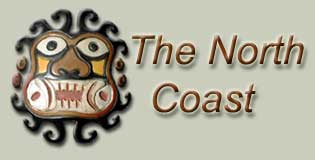
Fewer tourists visit this region since they focus on Machu Picchu and the southern areas; however, the North offers some of the finest and most important archeological sites in the Western hemisphere. Additionally, as we discovered, it is less crowded with tourists. We were able to visit archeology digs in progress and discuss the work with the scientists in the field. This page will describe several of the archeological sites we visited. We highly recommend that you include a tour of the archeology of the North Coast in your trip. Please be patient since there are many exciting pictures and it may take awhile to load this page.
We arrived in Trujillo from Lima; in Trujillo we stayed at the Hotel El Gran Marques. This was a good hotel, with excellent hot water and a good restaurant where we had some great seafood dishes.
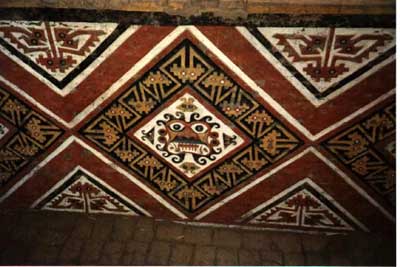 |
Our guide for our time in the Trujillo area was an interesting character. Oscar added some human interest to his guide narration; for example, on the long drive across the desert from Trujillo to Chiclayo, we told Peruvian ghost stories. On our first day in Trujillo, Oscar took us to visit the Moche site Huacas del Sol y de la Luna (the Temples of the Sun and the Moon.) The Huaca del Sol was the largest pre-Columbian structure in Peru; the Huaca de la Luna is smaller, but has some of the nicest friezes we saw including the relatively well-preserved features of El Decapitator: |
| The Moche civilization thrived about 2,000 years ago. They are well known for their ceramics, which are realistic depictions of people, animals, and everyday as well as ceremonial activities. The Moche were followed by the Chimu culture (1,000 to 1,470 AD.) The Chimu built the urban complex at Chan Chan. Here is a wall at the Moche site of La Huaca Arco Iris (Rainbow Temple). In the second photo, Oscar points out some aspects of the carvings. | 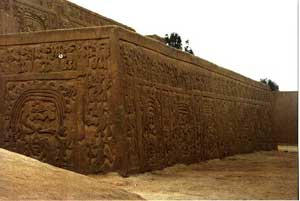
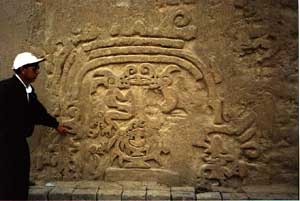
|

 |
These photos show the Chimu site of Chan Chan built around 1300 AD. Chan Chan is the largest adobe city in the world. As you can see, the centuries haven't been kind to a city built of mud. At one time it was home to over 60,000 people and contained gold, silver, and ceramics from the Chimu culture. The Inca conquered the Chimu in 1471. The city was not looted for its wealth though until the Spanish arrived. Much of what they missed was looted in the years since. The main area open to tourists at Chan Chan is the Tschudi complex. The second picture shows a close up of one of the wall carvings of a sea otter. Although it has been devastated by looters, by time, and especially by the occasional El Nino, Chan Chan is well worth your time! Ask Inkanatura to get you Oscar as your guide and go for it. As you tour the site, please note that Chan Chan has be designated as a World Heritage Site by UNESCO. It is also on the list of World Heritage sites in Danger. To read about the risks to this archeological treasure, please see UNESCO's report on the Chan Chan Archeological Zone. |
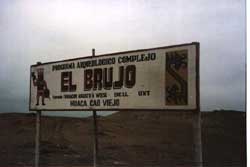 | ||
| The next morning, Oscar and our driver picked us up at our hotel for the 3 hour drive to Chiclayo. On the way we stopped at El Brujo. The Moche site of Huaca El Brujo is not often visited by tourists. You must make sure to go with a guide since it is located near the sea at the end of a long drive through sugar cane fields over bumpy roads and one dusty rough unpaved road. The Huaca Prieta people who first lived here around 3500 BC had no ceramics or large ceremonial structures. The temple at El Brujo dates from the Moche culture and there are also indications of later Lambayeque burials. The Moche temple is remarkable for its beautiful friezes depicting priests, warriors, and human sacrifices. If you look closely you can see the foot bones in the feet of this mural. | 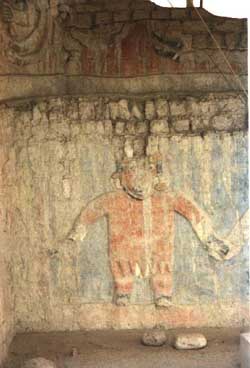 |
|
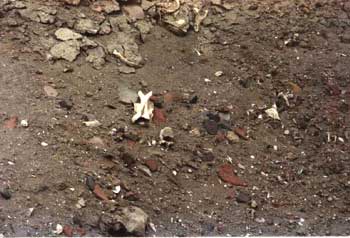
|
This photo shows the devastation of grave robbers at El Brujo.
You can just walk along and pick up pieces of pottery,textiless, and.... .. human bones. |
|
The Lonely Planet Guidebook describes thedestructionn wrought by hauaqueros, grave robbers, on page 346 of its guide to Peru. Huaqueros survive by stealing the undiscovered wealth of burial sites. They sell these goods on the underground antiquities market. It is illegal to export antiquities from Peru; however, we were offered supposedly "originales" several times on the street in Lima; (of course we were also offered a genuine Rolex too.) It may also be possible to obtain actual original pieces in the local markets in North coast towns. Please help Peru preserve its heritage and discourage the plundering of important archeological sites by demanding to purchase replicas. Responsible merchants will provide a certificate or at least a receipt stating that your purchase is a copy. The piece should also have copia or replica stamped on it.
In Chiclyao we visited The site of the excavations of El Senor de Sipan (The Lord of Sipan,) the Brunning Museum, and Tucume. Our guide in Chiclayo, Maggy, was very well verseded in the history and archeology of the area. We began with a trip to the site of the excavations of the Lord of Sipan. This web site at Tumbas Reales de Sipan describes some of the important finds. This site at the UNESCO Courier, Proud Descendents of the Lord of Sipan, offers an excellent interview with Dr. Walter Alva, who discovered the tombs in 1988. National Geographic Magazine has also featured a series of articles on the tombs. The Lord of Sipan is Peru's equivalent to Egypt's King Tut.
| The Lord was Moche and Moche peoples buried their dead in a
reclining position.
The Inca buried their dead in a fetal position. The photo on the left shows an
on-site reproduction of the Lord and
his retinue who accompanyed him on his journey to the afterlife
. Moche custom was to kill (or bury alive) the entire Lord's
household and family when he died with him. Including pets. The Lord was about 35
when he died;
since the average lifespan was 35-40, he did not die young for the time. The second
photo shows
a later
Inca era burial which has been left undisturbed by the archeologists. | |
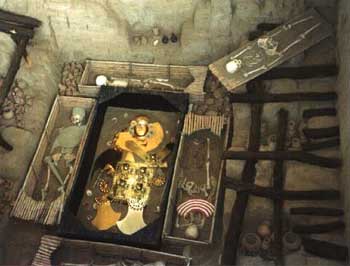 |
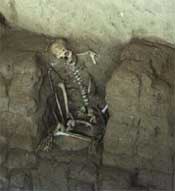 |
In the article linked above, Dr. Alva discussed how the excavations have impacted the local community, many of whom are descendents of the Moche and Lambayeque cultures. Our guide also discussed this and the relationship of the local people to the archeological sites. People live right on top of these sites. It is often farmers (or grave robbers) who first open the tombs. Dr. Alva and other archeologists have taken great care to build trust with the local people. It is important to contribute to their local economy with your purchase of souvenirs on site. In fact, don't miss the cabana/souvenirs/jerky stand at Sipan! I was able to get several neat pieces of real folk art that I know was produced locally; but I passed on the partially dried meat hanging from the rafter. | |
| The treasures of the Lord of Sipan are on exhibit in the Brunning Museum in Lambayeque. The Museum is a must see in order to truly understand the beauty and art of the Moche culture. However, it is not permitted to take pictures inside the Museum. | |
| Our final archeological site on the North coast was at Tucume, the
Valley of the 26 Pyramids. This is the site discovered and still under excavation by
Thor Heyerdahl. He was
supposedly there, but we didn't see him. We did see some excavations and the on site museum.
We climbed to the top of one pyramid to see the
panoramic view of the valley. It was worth the time to do so:
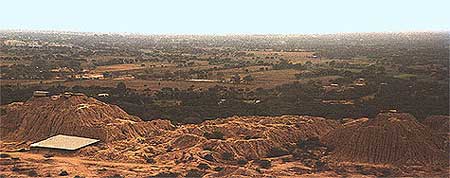 |
Back in Chiclayo, Maggy took us to the local market where we stopped by the stalls of the shamen. Don't miss this. We got good luck charms and herbal remedies. We took off that evening back to Lima for the final day of our long journey in Peru.
| | Peru | | | Photo Album | | | Cuzco | | | Machu Picchu| | | Amazon | | | Sacred Valley | | | Altiplano | | | Lake Titicaca | | | Trujillo/Chiclayo | | | Lima | | | Environment | | | Travel Tips | |